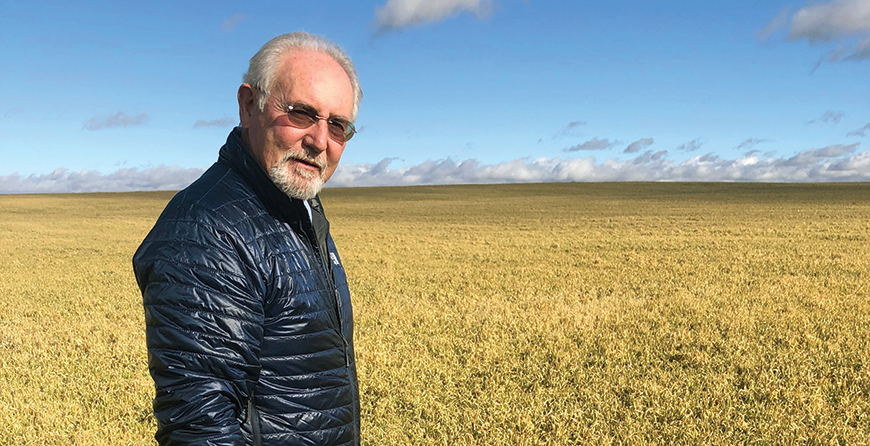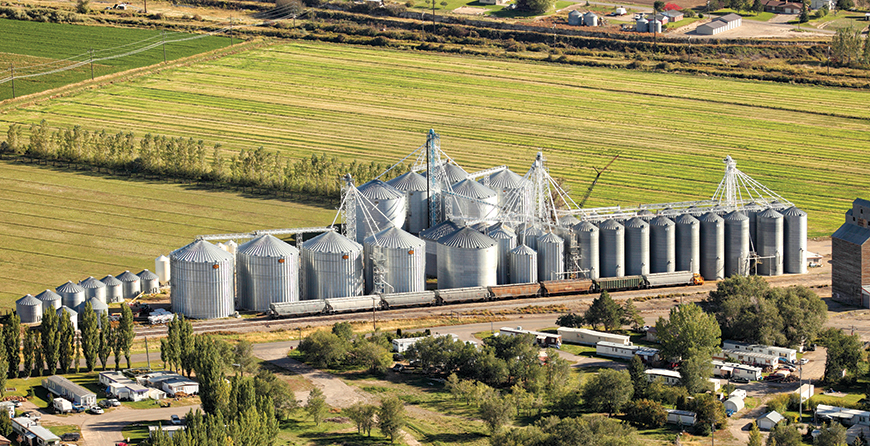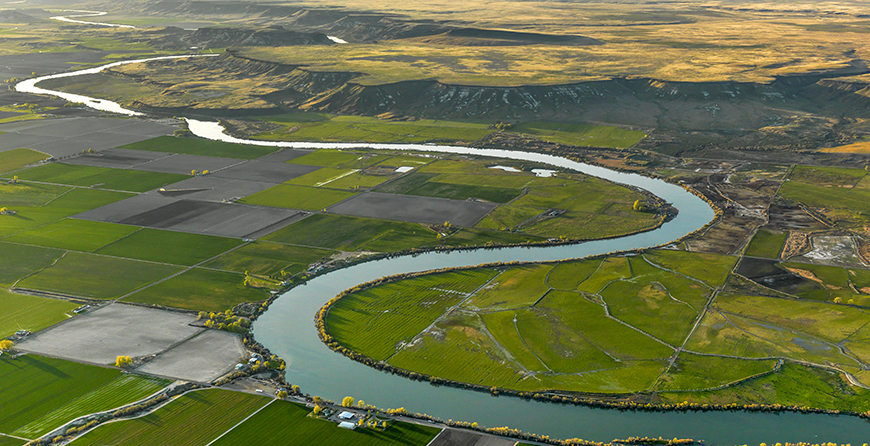Karl Joslin is a man shaped by southern Idaho’s fertile desert soils. A third-generation farmer who was born near Salmon Falls Creek south of Twin Falls, Joslin embodies the idea that farming can be a multi-generational family affair.
“My dad was a farmer. My grandfather was a farmer. I was raised on the farm and grew up with the farm,” said the 65-year-old owner of Joslin Organic Farms during a recent tour of his properties. “I went away to college and decided it was in fact a good way for me to make a living and enjoy doing it. So, I came back to the farm, and here we are.”
Joslin specializes in organic farming and grows black, red and pinto beans he sells to Amy’s Kitchen, as well as alfalfa, wheat, corn and barley he sells primarily to a nearby organic dairy. In turn, the dairy will sell to cheese, milk and yogurt producers in the region. Cementing his position in an interrelated economic machine, Joslin also buys waste from nearby trout farmers to help fertilize his fields.

Karl Joslin is a third-generation farmer in the Magic Valley. Photo by Greg Stahl
It’s all part of a massive industry that boosters say lies at the foundation of Idaho’s economy. Each year, the Idaho State Department of Agriculture estimates that Idaho growers, livestock producers and aquaculture generate $16 billion in direct and indirect spending, a figure bested only by the rapidly-growing tech sector.
“We always talk about ag as the cultural foundation of Idaho, and also the economic foundation,” said Idaho State Department of Agriculture Chief Operating Officer Chanel Tewalt. “In whatever community you go to, whether it’s Boise or Burley, which is very ag-centric, you’re going to have ag dollars flowing through the economy, and I hope some cultural recognition of that.”
When a motorist arrives in the Magic Valley of southern Idaho the footprint of a diverse agricultural economy quickly becomes apparent. There are hay bales in fields; milk, hay and livestock trucks plying the highways; and irrigation ditches working in most every direction to deliver water to ground that would otherwise qualify as high desert. Road signs advertise industrial farm and irrigation equipment, and it’s easy to spot massive food storage shelters among center pivots and farm fields. It doesn’t even take a trained eye. The diverse infrastructure that supports a healthy system of agricultural supply and demand is plain.
“The Magic Valley is the absolute epicenter of Idaho ag whether you’re looking at yields or dollars, but it’s good to point out that every region of the state has something going on that’s ag related,” Tewalt said.
The Magic Valley is a huge producer of dairy, potatoes and sugar beets. With freshwater springs emerging from the Snake Plain Aquifer near Hagerman, it’s also the nation’s leading producer of commercial trout.
The Treasure Valley in and around Boise produces a diverse array of crops, including hops for beer and grapes for wine, but it’s also recognized internationally for commercial seed production. The Camas Prairie of central Idaho and the Palouse hills to the north produce beans, peas, lentils and wheat. And communities throughout central Idaho where there’s abundant public land for grazing raise significant numbers of cattle and sheep.

Granaries near Ririe, Idaho.
According to statistics compiled by University of Idaho researchers, agriculture produces more sales than any other economic sector in Idaho. Twenty percent of sales come back to agriculture, and it accounts for 16 percent of the state’s gross domestic product and 14 percent of its jobs. These are numbers bested only by the tech sector, which Tewalt said has proved more volatile and subject to market variability.
“A lot of folks in Idaho want to look at the state as growing into a very well-rounded economy, and we are, but ag still plays a foundational role in that,” she said. “Ag isn’t shrinking, but everything else is growing, too,” so its share of the pie is changing.
Tewalt also pointed out that agriculture tends to do well when other economic indictors slip. In 2008 during the Great Recession, agriculture regained its place as Idaho’s number one industry, and agricultural exports set records. She explained that in a poor economy it’s easier to find labor and the dollar is weak against foreign currencies, which helps exports.
Idaho’s red, white and blue license plate proudly honors “Famous Potatoes,” and the state leads the nation in potato production. Idaho grows more than 14 billion pounds of spuds on more than 300,000 acres, a bounty highlighted by state and industry marketing departments. There’s an annual New Year’s Eve potato drop, a state mascot named Spuddy Buddy, and a giant potato hauled by a gleaming red semi-truck. Even so, potatoes aren’t even the state’s top crop. Dairy and livestock far and away constitute the largest portion of the Gem State’s agricultural production.
“Overall in Idaho our top ag sectors are dairy, beef, potatoes, wheat, and hay,” Tewalt said. “The overall trend to keep track of there is how huge the livestock sector is. I’d say 50 to 60 percent of the overall ag revenue pie is dairy and beef cattle. And we’re a state that has more cattle than people. There are 2.2 million cows and 1.7 to 1.8 million people.”
A Family Legacy
From onions to sugar beats and a whole lot more, Idaho boasts a cornucopia of food production and processing. If Idahoans had to eat everything grown in the state each resident would have to eat 180 slices of bread, 43 potatoes, two onions, 2 pounds of cheese, 2 pounds of beef and 3 cups of beans—every day.
Karl Joslin has silver hair and a matching gray goatee. He stands about 6 feet tall and wore blue jeans and sneakers during our tour of his south-Idaho farm, which spans about 15 parcels collectively forming a 4,000-acre operation. He aimed his four-door pickup west on a road called East 2900 North and crossed a small divide between the Rock Creek and Salmon Falls Creek drainage basins south of Twin Falls. He’d just finished giving a tour of some of his newer land acquisitions near the Snake River Canyon where he’d planted the fields in a fall and winter cover crop to prevent erosion and help saturate the soil with nutrients in preparation for spring planting.
“We’re getting into what we call the Salmon tract,” he said pointing west toward Salmon Falls Creek and the small town of Hollister. “This is home base. My grandfather settled in Rogerson (just a little farther south). Salmon Dam wasn’t in, and he helped build the reservoir. He settled in Rogerson because of the dream of irrigation water. He helped build the reservoir and the canal system.”
Joslin pulled a magazine out of the back seat to show off its cover. It depicted a mature farmer’s roughened hand reaching down to touch a child’s. “Farming takes a green thumb,” he said. “It may or may not be that your family will continue to farm. They may not have a natural affinity for it. In a perfect world, that’s what you hope for, because my land is going to be here when I’m gone. My grandfather is gone; my father is gone. I’m here; my son is here; my grandson is here. Hopefully they’ll enjoy it, but if ever they don’t, they should get rid of it and give it to someone who does.”
When Joslin graduated from college at University of Idaho in 1975 he returned to the family farm. He plays down the 4,000 acres he’s cobbled together as a “quiet little organic operation,” but that belies his humble beginnings. When he returned from college, the family farm was 160 acres—the size parcel bequeathed under the Homestead Act of 1862.
“When I first came back to Twin Falls, what I owned was a shovel, irrigating boots and a pair of gloves,” he said. “You start with whatever you start with and then add on to that. It’s like a snowball. Once you get a snowball started it grows quickly.”
When he talks about farming, Joslin conveys passion that goes beyond stereotypes about it. He’s an intelligent, forward-looking businessman who says he’s worked hard to stay ahead of the curve. While organic farming has been a good niche, he actually fell into it because the dairy that buys most of his alfalfa and corn had already chosen that path. His 15-years-ago choice to supply organic feed crops to the dairy, combined with a self-described ability to build and follow through on a plan, have helped the farm to consistently grow and prosper.
“We do things that help the ground become fertile,” he said. “We use cover crops. We always keep something growing. That green growth holds the ground down, stops wind erosion, uses the winter moisture, creates a root mass and an organic mass above the soil. In the spring, we work that in. So as it breaks down, that organic material is your fertilizer. We’re really using the farm as a big compost. It’s just a solar collector and a compost generator.”
Joslin has been a proactive businessman in other ways, too. He lined irrigation ditches to waste less water and, notably, installed gravity-fed irrigation pivots on three quarters of his fields. Many of his fields are fed with water that’s a hundred or so feet above level, so he installed pipes to harness the potential energy created by gravity in order to pump water. It has essentially eliminated 75 percent of his electricity bill. He’s also thinking about installing solar panels to help offset the power costs of irrigation pivots that aren’t near a hillside.
“It’s what farming is now. It’s a business,” he said. “It’s like many other businesses. You have to be on top of it. You have to be ahead of the curve and proactive.”
Idaho’s Success Stories
From alfalfa to potatoes, Idaho has numerous economic success stories from which to choose, and they date back more than a hundred years. In 2012, Chobani opened the world’s largest yogurt plant in Twin Falls in close proximity to the state’s rapidly growing dairy industry. Just last year Chobani announced plans for a $20 million expansion to the existing $450 million facility where 2,000 southern Idaho residents are employed. Gambia Foods is another Twin Falls-based dairy processor and markets 830 million pounds of cheese and 170 million pounds of whey to more than 30 nations. It employs more than 1,000 people.
Despite these and thousands of other Idaho success stories, the state is possibly best known for a company named after an eighth-grade dropout named J.R. Simplot. Simplot began his colorful career in 1923 in Declo, Idaho, one of the state’s dozens of south-Idaho farm towns, where he dropped out of school at age 14 to go into business on his own. With a foot already solidly in the potato farming world, Simplot won a potato sorter in a coin toss in 1929 and began traveling the state to sort potatoes grown by its rural farmers. He was soon buying and selling potatoes, opening warehouses and building relationships with people in positions of influence.
According to marketing materials from the Simplot Co., Simplot’s ingenuity and determination set the company on an innovative course. When wartime shortages made it difficult to buy fertilizer he built a manufacturing plant in Pocatello and made his own. In the 1940s, he invented and marketed the first commercially viable frozen French fries and, two decades later, became the exclusive supplier of fries to the flourishing McDonald’s restaurant chain.
And although the Simplot Co. got its start in farming, livestock became its eventual focus.
“What ended up happening was, as he was growing all of these things, he identified that waste was produced,” said Simplot Senior Communication Manager Josh Jordan. “So potato waste started going to livestock. By 1977, it had pretty much converted to be solely a cattle operation.”
The evolution continues today, and Jordan said the company is now divided into three divisions domestically. Agribusiness includes mining and phosphate production (used in fertilizers and nutritional supplements for animals) and retail. Land and Livestock is the aforementioned livestock division. Food comprises vegetable, fruit, and potato production. The company has a fourth division in Australia specializing in retail food sales.
“There are some misconceptions about what agriculture means and what it’s become over the years,” Jordan said. “If your primary goal is to make sure there’s food on people’s tables, that means a lot. In Idaho, as we continue to urbanize and grow, we can’t overlook the importance agriculture has had in the growth of the state and the future of the state.”
Jordan said Simplot employs 800 people at the company’s new, highly visible headquarters at the JUMP campus in downtown Boise and 2,500 people throughout Idaho. It employs a total of 5,000 in North America. The company has come a long way since a kid from south Idaho dropped out of school and pursued a dream with dogged determination and an eye for innovation.
A Way of Life
From north Idaho’s fields of wheat and beans to south Idaho’s sweeping potato fields and trout farms, Idaho agriculture is diverse. The state has 25,000 farms and ranches producing more than 185 commodities. And the people behind the farms are part of the fabric that makes Idaho unique.
“People who are involved in ag are a special type of person,” Tewalt said. “The hours are long, the pay can be pretty terrible, the work is arduous. That’s not a tremendously attractive help-wanted poster. So why do people do it? It comes back to the lifestyle. It’s a way of life, and it’s a chosen way of life. Ag is so much bigger than us. It takes us outside. It is often completely outside our control—weather, natural disasters—and there’s a lot of heartbreak in that sometimes. So those are special people who choose to do it despite all of those things.”
She might as well have been describing Joslin in his own, slightly more simplistic words.
“Why do I farm?” he asked. “Because I enjoy it.”

